Nico
I added .wav to the name of the files to be saved, and they then played back O.K. with Creative Media Source Player.I preferred the cleaner sound of the later file, although I had to turn my attenuator up a notch.
SandyK
(Asus Xonar-spdif-mod. MF X-DAC V3-Class A HA, ATH W1000 headphones.)
I added .wav to the name of the files to be saved, and they then played back O.K. with Creative Media Source Player.I preferred the cleaner sound of the later file, although I had to turn my attenuator up a notch.
SandyK
(Asus Xonar-spdif-mod. MF X-DAC V3-Class A HA, ATH W1000 headphones.)
no.Have you got Skype?
I had messenger set up, but lost it a couple of updates ago.
Nico
The difference in volume may be giving me misleading results, because even with 1 step of the 24position attenuator, I can't quite get the level right. My best compromise makes the 2nd track a fraction louder.
SandyK
P.S. It also gives the appearance of a difference in dynamics between the 2 files.
The difference in volume may be giving me misleading results, because even with 1 step of the 24position attenuator, I can't quite get the level right. My best compromise makes the 2nd track a fraction louder.
SandyK
P.S. It also gives the appearance of a difference in dynamics between the 2 files.
Last edited:
Sandy the one track is 1.3 dB higher than the other. Okay this took me several hours, take a look at this. Lets decide on what the amp will sound like by looking at a picture. I put the two left hand channels together for easier spot the difference.
I am done here.
http://digisec.co.za/temp/untitled.bmp
I am done here.
http://digisec.co.za/temp/untitled.bmp
This adds to the total confusion of how something sounds like.
From the plots one can immediately see the difference and believe me that the ear is much more sensitive to variations than these plots. Maybe you audiophiles must choose which plot is the better or more realistic of the two.
I think the hocus pocus and buzz word stuff now comes to the forefront.
I must admit, this is the first time I ever thought of comparing on this scale. John I wonder if you are any wiser, because I am not.
Would anyone (Hugh) want to take a stab at which one is closest to the valve sound?
Nico
From the plots one can immediately see the difference and believe me that the ear is much more sensitive to variations than these plots. Maybe you audiophiles must choose which plot is the better or more realistic of the two.
I think the hocus pocus and buzz word stuff now comes to the forefront.
I must admit, this is the first time I ever thought of comparing on this scale. John I wonder if you are any wiser, because I am not.
Would anyone (Hugh) want to take a stab at which one is closest to the valve sound?
Nico
Thanks Nico,
I have both samples. I listened to both on headphones first and didn't hear much of a difference (not very good headphones). I then listened on my speakers and again, there wasn't much of a difference. I didn't have a base for comparison (no Tracy Chapman in my collection), so I turned to the handy torrent search D) and found a reasonable copy (variable bit rate .wma).
D) and found a reasonable copy (variable bit rate .wma).
Listening once again revealed not much of a difference.
I opened each of the samples with Adobe Audition to take a closer look. The second sample is at a different volume - lower:
(sample 1 left, sample 2 right)
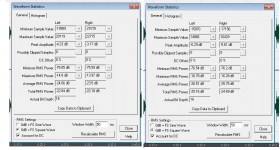
Frequency response is quite a bit different.
Sample one:
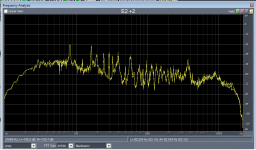
Sample two:
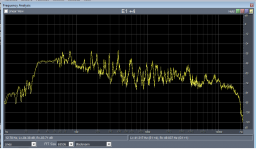
When I compare these to the version I downloaded (for scientific pursuits ), sample 2 looks like the more accurate.
), sample 2 looks like the more accurate.
Freq response of the .wma file:
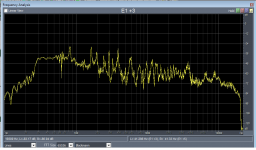
I have both samples. I listened to both on headphones first and didn't hear much of a difference (not very good headphones). I then listened on my speakers and again, there wasn't much of a difference. I didn't have a base for comparison (no Tracy Chapman in my collection), so I turned to the handy torrent search
Listening once again revealed not much of a difference.
I opened each of the samples with Adobe Audition to take a closer look. The second sample is at a different volume - lower:
(sample 1 left, sample 2 right)

Frequency response is quite a bit different.
Sample one:

Sample two:

When I compare these to the version I downloaded (for scientific pursuits
Freq response of the .wma file:

I must admit, this is the first time I ever thought of comparing on this scale. John I wonder if you are any wiser, because I am not.
No wiser I assure you
I ALWAYS look deeper, not take anything at face value. I try to use the tools that are at my disposal to better my understanding and keep my perceptions in check.
Here`s the statistics for the .wma file:
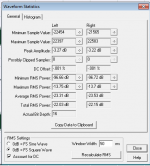
Notice the difference in max signal to min signal and compare to the ones above.
Anyone else out there that may be able to give Andrew some advice?
Right click,`save target as`.
Should save as .wav files in your chosen location - it did for me.
John have a very close look at my two graphs and you would see some detail missing in one, also the wave shape slightly rounded. The traces are of about 10 mS of signal.
When I listen to the two one definately lacks some detail as well. I don't want to reveal yet which is which, it would spoil my hard work synchronising two signals exactly.
When I listen to the two one definately lacks some detail as well. I don't want to reveal yet which is which, it would spoil my hard work synchronising two signals exactly.
At a glance, and taking in the whole trace,amp 2 looks a little more rounded off. But if I look at small segments, some parts of amp 1 look a bit rounded compared to amp 2. Perhaps that's a limitation of the measurement/display. Overall, I'd say amp 1 should sound more "detailed".
Sheldon
Sheldon
SandyK made an observation to what he thinks of the sound, I would like others to try also.
It takes quite a bit of practice to listen to something in detail and not just to the overall sound. Try picking some instrument or passage in the production and compare it to how it sounded on the other example. Do this a few times with different things and moments, try to hear what detail is hidden in the background, etc.
It is like watching the famous movie, The Party starring Peter Sellers. When watching it the fourth time you don't look at the main characters but at what is happening in the background and you will find other screaming funny scenes that you never knew existed when you watched it the first few times.
Problem is most people focus on the main scene. If you were trained in the military you are though to use peripheral vision and you see much more than meets the eye, enough to save your life.
Also you are taught to listen to many things at once and you can filter many different sounds on which to concentrate. It takes some practice but it works. In a crowd there may be many conversations going on but you can learn to easily focus on any one you chose and when you get good at it you can listen to many and follow all of them.
This is what COMINT teaches the operators eavesdropping on radio communications. They can follow several communications networks simultaneously and report on them individually.
That is why I said there are two listening sessions, you can listen to the equipment, in other words listen to the relationship of signals to each other, and then you can listen to the music in other words the way everything blends with each other to make it an enjoyable experience.
For most people it is about the enjoyment of the tune and they can listen to it even on a mediocre iPod or cellular phone or pocket radio. If this was not the case musicians would be very poor people and number one hits would not exist.
Nowadays, they do not even make music, it is a constant thumping electronically generated 70 Hz signal with monotone senseless verbal diarrhea and gyrating half naked black and semi black men and woman rubbing their crotches. For this you do not need a good amplifier and any 3000 watt PMPO large plastic box from the Far East will do fine.
It takes quite a bit of practice to listen to something in detail and not just to the overall sound. Try picking some instrument or passage in the production and compare it to how it sounded on the other example. Do this a few times with different things and moments, try to hear what detail is hidden in the background, etc.
It is like watching the famous movie, The Party starring Peter Sellers. When watching it the fourth time you don't look at the main characters but at what is happening in the background and you will find other screaming funny scenes that you never knew existed when you watched it the first few times.
Problem is most people focus on the main scene. If you were trained in the military you are though to use peripheral vision and you see much more than meets the eye, enough to save your life.
Also you are taught to listen to many things at once and you can filter many different sounds on which to concentrate. It takes some practice but it works. In a crowd there may be many conversations going on but you can learn to easily focus on any one you chose and when you get good at it you can listen to many and follow all of them.
This is what COMINT teaches the operators eavesdropping on radio communications. They can follow several communications networks simultaneously and report on them individually.
That is why I said there are two listening sessions, you can listen to the equipment, in other words listen to the relationship of signals to each other, and then you can listen to the music in other words the way everything blends with each other to make it an enjoyable experience.
For most people it is about the enjoyment of the tune and they can listen to it even on a mediocre iPod or cellular phone or pocket radio. If this was not the case musicians would be very poor people and number one hits would not exist.
Nowadays, they do not even make music, it is a constant thumping electronically generated 70 Hz signal with monotone senseless verbal diarrhea and gyrating half naked black and semi black men and woman rubbing their crotches. For this you do not need a good amplifier and any 3000 watt PMPO large plastic box from the Far East will do fine.
John have a very close look at my two graphs and you would see some detail missing in one, also the wave shape slightly rounded. The traces are of about 10 mS of signal.
When I listen to the two one definately lacks some detail as well. I don't want to reveal yet which is which, it would spoil my hard work synchronising two signals exactly.
Hi Nico,
Yes, I did and I've been working to do the same here. Results:
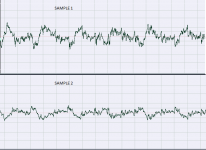
They appear to be out of phase also. It took some time to get them synchronized.
Hi Sheldon, try listening to the two recording and then decide which one sounds more detailed, warmer cooler or whatever, which appeals to you. I have chosen that track for some particular reasons. Besides the particular recording was been mic'ed with dummy head in a warehouse.
- Home
- More Vendors...
- AKSA
- Aspen Headphone Amp